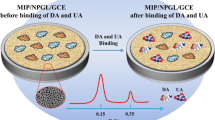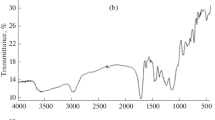Abstract
The authors describe boronate-modified hollow dummy template imprinted polymers (B-hDIPs) for selective and sensitive extraction of the catecholamines norepinephrine (NE), epinephrine (E), and dopamine (DA) from urine samples prior to their detection by HPLC with UV detector. The B-hDIPs were prepared by using (a) nano-TiO2 as the sacrificial support, (b) 3-carboxyphenylboronic acid (CPBA) as the boronate-affinity functional monomer, and (c) catechol which acts as dummy template. The nano-TiO2 can be etched off by using hydrofluoric acid to form the hollow imprint. The main advantages of using such hollow polymers arise from their controllable hole structure which favors template removal and fast mass transfer. The B-hDIPs material was characterized by FT-IR, transmission electron microscope, dynamic light scattering, X-ray photoelectron spectrum, and thermal gravimetric analysis. The effects of imprinting conditions, sample pH, sample flow rate, adsorbent amount, selectivity and competitive capacities were investigated. Under optimal conditions, the limits of detection for the catecholamines are in the range from 15 to 47 ng mL−1. The method was successfully applied to their determination of NE, E, and DA in spiked urine, with recoveries ranging from 63.4 to 106.2%.

Schematic presentation of boronate-modified hollow dummy template imprinted polymers as an adsorbent to extraction of the catecholamines (norepinephrine, epinephrine, and dopamine) from urine samples prior to their detection by HPLC-UV.





Similar content being viewed by others
References
De Nardi F, Lefort C, Bréard D, Richomme P, Legros C, Guérineau NC (2017) Monitoring the secretory behavior of the rat adrenal medulla by high-performance liquid chromatography-based catecholamine assay from slice supernatants. Front Endocrinol 8:248
Bouri M, Lerma-García MJ, Salghi R, Zougagh M, Ríos A (2012) Selective extraction and determination of catecholamines in urine samples by using a dopamine magnetic molecularly imprinted polymer and capillary electrophoresis. Talanta 99:897–903
Josypčuk O, Barek J, Josypčuk B (2018) Amperometric determination of catecholamines by enzymatic biosensors in flow systems. Electroanal 30:1163–1171
Zheng JM, Mandal R, Wishart DS (2018) A sensitive, high-throughput LC-MS/MS method for measuring catecholamines in low volume serum. Anal Chim Acta 1037:159–167
De Jong WHA, De Vries EGE, Wolffenbuttel BHR, Kema IP (2010) Automated mass spectrometric analysis of urinary free catecholamines using on-line solid phase extraction. J Chromatogr B 878:1506–1512
Yang XT, Hu YF, Li GK (2014) Online micro-solid-phase extraction based on boronate affinity monolithic column coupled with high-performance liquid chromatography for the determination of monoamine neurotransmitters in human urine. J Chromatogr A 1342:37–43
Ma JB, Qiu HW, Rui QH, Liao YF, Chen YM, Xu J, Zhan PP, Zhao YG (2016) Fast determination of catecholamines in human plasma using carboxyl-functionalized magnetic-carbon nanotube molecularly imprinted polymer followed by liquid chromatography-tandem quadrupole mass spectrometry. J Chromatogr A 1429:86–96
Zhang XF, Xu SX, Lim JM, Lee YI (2012) Molecularly imprinted solid phase microextraction fiber for trace analysis of catecholamines in urine and serum samples by capillary electrophoresis. Talanta 99:270–276
Yan MM, She YX, Cao XL, Ma J, Chen G, Hong SH, Shao Y, Abd EI-Aty AM, Wang M, Wang J (2019) A molecularly imprinted polymer with integrated gold nanoparticles for surface enhanced Raman scattering based detection of the triazine herbicides, prometryn and simetryn. Microchim Acta 186:215
Yang ZY, Cai QZ, Chen N, Zhou XM, Hong JL (2016) Selective separation and identification of metabolite groups of Polygonum cuspidatum extract in rat plasma using dispersion solid-phase extraction by magnetic molecularly imprinted polymers coupled with LC/Q-TOF-MS. RSC Adv 6:12193–12204
Zhang JW, Tan L, Zhang YZ, Zheng GC, Xia ZN, Wang CZ, Zhou LD, Zhang QH, Yuan CS (2018) Debittering of lemon juice using surface molecularly imprinted polymers and the utilization of limonin. J Chromatogr B 1104:205–211
Wang JQ, Huyan Y, Yang ZT, Zhang HP, Zhang AB, Kou XK, Zhang QY, Zhang BL (2019) Preparation of surface protein imprinted thermosensitive polymer monolithic column and its specific adsorption for BSA. Talanta 200:526–536
Han Q, Shen X, Zhu WY, Zhu CH, Zhou XM, Jiang HJ (2016) Magnetic sensing film based on Fe3O4@Au-GSH molecularly imprinted polymers for the electrochemical detection of estradiol. Biosens Bioelectron 79:180–186
Wang P, Liu JX, Chen XP, Ma XM, Guo DZ, Li ZJ, Pan JM (2019) Janus silica nanosheets-based mmips platform for synergetic selective capture and fast separation of 2′-deoxyadenosine: two different components segmented on the surface of one object. Chem Eng J 369:793–802
Hu Y, Xia QF, Huang W, Hou XY, Tian MM (2018) Boronate-modified hollow molecularly imprinted polymers for selective enrichment of glycosides. Microchim Acta 185:46
Tang WJ, Zhao T, Zhou CH, Guan XJ, Zhang HX (2014) Preparation of hollow molecular imprinting polymer for determination of ofloxacin in milk. Anal Methods 6:3309–3315
Lu HZ, Xu SF (2017) Hollow mesoporous structured molecularly imprinted polymers for highly sensitive and selective detection of estrogens from food samples. J Chromatogr A 1501:10–17
Fan DX, Li H, Shi SY, Chen XQ (2016) Hollow molecular imprinted polymers towards rapid, effective and selective extraction of caffeic acid from fruits. J Chromatogr A 1470:27–32
Li H, Li G, Li ZP, Lu CM, Li YN, Tan XZ (2013) Surface imprinting on nano-TiO2 as sacrificial material for the preparation of hollow chlorogenic acid imprinted polymer and its recognition behavior. Appl Surf Sci 264:644–652
Ahmed MA, Abdelbar NM, Mohamed AA (2018) Molecular imprinted chitosan-TiO2 nanocomposite for the selective removal of rose Bengal from wastewater. Int J Biol Macromol 107:1046–1053
Zhang CJ, Bai WB, Yang ZP (2016) A novel photoelectrochemical sensor for bilirubin based on porous transparent TiO2 and molecularly imprinted polypyrrole. Electrochim Acta 187:451–456
Li L, Lu Y, Bie ZJ, Chen HY, Liu Z (2013) Photolithographic boronate affinity molecular imprinting: a general and facile approach for glycoprotein imprinting. Angew Chem Int Ed 52:7451–7454
Li DJ, Li Y, Li XL, Bie ZJ, Pan XH, Zhang Q, Liu Z (2015) A high boronate avidity monolithic capillary for the selective enrichment of trace glycoproteins. J Chromatogr A 1384:88–96
Fang WL, Xia LJ, Huang X, Guo XF, Ding J, Wang H, Feng YQ (2018) Highly sensitive determination for catecholamines using boronate affinity polymer monolith microextraction with in-situ derivatization and HPLC fluorescence detection. Chromatographia 81:1381–1389
Marć M, Panuszko A, Namieśnik J, Wieczorek PP (2018) Preparation and characterization of dummy-template molecularly imprinted polymers as potential sorbents for the recognition of selected polybrominated diphenyl ethers. Anal Chim Acta 1030:77–95
Peng MJ, Xiang HY, Hu X, Shi SY, Chen XQ (2016) Boronate affinity-based surface molecularly imprinted polymers using glucose as fragment template for excellent recognition of glucosides. J Chromatogr A 1474:8–13
Xu WZ, Zhou W, Xu PP, Pan JM, Wu XY, Yan YS (2011) A molecularly imprinted polymer based on TiO2 as a sacrificial support for selective recognition of dibenzothiophene. Chem Eng J 172:191–198
Chen LQ, Wang H, Xu Z, Zhang QY, Liu J, Shen J, Zhang WQ (2018) High-throughput and selective solid-phase extraction of urinary catecholamines by crown ether-modified resin composite fiber. J Chromatogr A 1561:48–55
Vardini MT, Mardani L (2018) Surface imprinting of silica gel by methyldopa and its application in the solid phase extraction procedure. J Braz Chem Soc 29:310–319
Yang LM, Liu SF, Zhang QX, Li F (2012) Simultaneous electrochemical determination of dopamine and ascorbic acid using AuNPs@polyaniline core-shell nanocomposites modified electrode. Talanta 89:136–141
Casella IG, Gioia D, Rutilo M (2018) A multi-walled carbon nanotubes/cellulose acetate composite electrode (MWCNT/CA) as sensing probe for the amperometric determination of some catecholamines. Sensors Actuators B Chem 255:3533–3540
Izaoumen N, Cubillana-Aguilera LM, Naranjo-Rodriguez L, Cisneros JLHH, De BD, Temsamani KR, Palacios-Santander JM (2009) β-Sonogel-carbon electrodes: a new alternative for the electrochemical determination of catecholamines. Talanta 78:370–376
Ghasemi F, Hormozi-Nezhad MR, Mahmoudi M (2016) Identification of catecholamine neurotransmitters using fluorescence sensor array. Anal Chim Acta 917:85–92
Qin ZC, Jiang YX, Piao HL, Tao S, Sun Y, Wang XH, Ma PY, Song DQ (2019) Packed hybrids of gold nanoparticles and halloysite nanotubes for dispersive solid phase extraction of triazine herbicides, and their subsequent determination by HPLC. Microchim Acta 186:489
Acknowledgements
The study was supported by the University Nursing Program for Young Scholars with Creative Talents in Heilongjiang Province (UNPYSCT-2018179). The support from Harbin Normal University (XKB201401) is also acknowledged.
Author information
Authors and Affiliations
Corresponding author
Ethics declarations
Conflict of interest
The author(s) declare that they have no competing interests.
Additional information
Publisher’s note
Springer Nature remains neutral with regard to jurisdictional claims in published maps and institutional affiliations.
Electronic supplementary material
ESM 1
(DOC 245 kb)
Rights and permissions
About this article
Cite this article
Hou, X., Huang, W., Tong, Y. et al. Hollow dummy template imprinted boronate-modified polymers for extraction of norepinephrine, epinephrine and dopamine prior to quantitation by HPLC. Microchim Acta 186, 686 (2019). https://doi.org/10.1007/s00604-019-3801-2
Received:
Accepted:
Published:
DOI: https://doi.org/10.1007/s00604-019-3801-2




